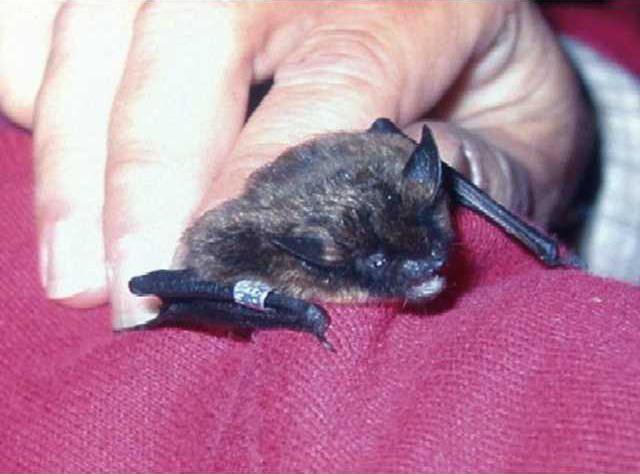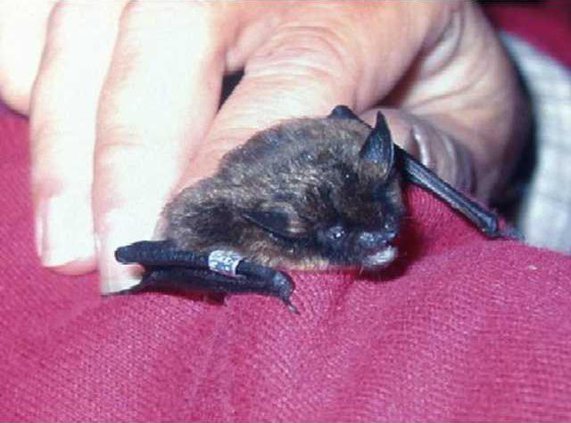SOCIAL CIRCLE — A student’s summer spent slogging through Georgia swamps with a flashlight in hand has shed light on the range and favored shelter of a most secretive bat.
Matt Clement, a graduate student in the Warnell School of Forestry and Natural Resources at the University of Georgia, wanted to find at least 30 Rafinesque’s big-eared bats, a number approximately equal to previously documented records of the species in Georgia. He also hoped to characterize the bat’s roosting habitat.
But Clement’s systematic probing along river bottoms in three management areas turned up about 565 of these rare mammals with rabbit-like ears. The research initiated by Warnell faculty member Dr. Steven Castleberry and funded by the Georgia Wildlife Resources Division and UGA also identified large, hollow water tupelo trees as key roost sites. Such trees have become relatively scarce yet can still be found in some bottomlands inaccessible to logging.
Clement said the findings greatly expand the known distribution of Rafinesque’s big-eared bats in Georgia and “deeply refine our understanding of their habitat preferences.”
The insight can help manage an under-studied species rated as a high priority in the state’s conservation roadmap, the Wildlife Action Plan, according to Jim Ozier of the WRD Nongame Conservation Section.
“Too often, the value of big, old trees that develop large cavities is overlooked,” said Ozier, a Nongame Conservation program manager.
“Many habitat types and components can be managed relatively
easily. However, nothing but time can produce these mature forests.”
Rafinesque’s big-eared bats range throughout the Southeast but are considered abundant nowhere. Weighing no more than a half-ounce and measuring three to four inches long, they favor forests, flying insects and darkness, not emerging from roosts until evening has faded to night.
Ears more than an inch long help pinpoint insects through echolocation. The bats emit high-frequency sounds that bounce off prey and other objects, then interpret the returning sounds to produce a picture of the surroundings.
Ozier said Clement’s bat discoveries “confirm what we hoped and thought might be there.”
From May through August, Clement and a helper followed randomly picked, 500-meter transects through bottomlands marked as frequently or rarely flooded on Tuckahoe Wildlife Management Area near Sylvania, Moody Forest Natural Area near Baxley and Ocmulgee WMA near Cochran. Each Coastal Plain site is along a major river. Tuckahoe is on the Savannah River; Moody, the Altamaha; and Ocmulgee, the same river.
Clement checked hollow trees near the transect lines, shining a million-candle power light into the trees — usually through ground-level openings — and counting roosting bats. He used a hand mirror for hollows to small for his head.
He found 97 roosts with Rafinesque’s big-eared bats. Two trees in Tuckahoe had more than 120 bats each. None of the roosts were in rarely flooded areas, although some radio-tagged bats flew into those areas, he said.
While still analyzing data, Clement theorizes that water tupelos dominated as roosts because they tend to grow big, hollow and in frequently flooded cypress-gum swamps, which provide the protection from logging needed to reach old age.
“It’s the inaccessible sites that support the large hollow trees,” he said.
Clement is planning more research this summer. But he is already close to the project’s ultimate goal: Being able to predict where these uncommon bats with the big ears can be found.
Buying a wildlife license plate or making a donation through the state income tax checkoff supports conservation of big-eared bats and other nongame species. The tax checkoff and sales of bald eagle and hummingbird tags provide vital funding for the Nongame Conservation
Section, which receives no state appropriations.
Wildlife tags are available for $25 at county tag offices, online at http://mvd.dor.ga.gov/tags or via mail-in registration forms. The “Give Wildlife a Chance” tax checkoff is line 26 of the long tax form (Form 500) or line 10 of the short form (Form 500EZ).
Matt Clement, a graduate student in the Warnell School of Forestry and Natural Resources at the University of Georgia, wanted to find at least 30 Rafinesque’s big-eared bats, a number approximately equal to previously documented records of the species in Georgia. He also hoped to characterize the bat’s roosting habitat.
But Clement’s systematic probing along river bottoms in three management areas turned up about 565 of these rare mammals with rabbit-like ears. The research initiated by Warnell faculty member Dr. Steven Castleberry and funded by the Georgia Wildlife Resources Division and UGA also identified large, hollow water tupelo trees as key roost sites. Such trees have become relatively scarce yet can still be found in some bottomlands inaccessible to logging.
Clement said the findings greatly expand the known distribution of Rafinesque’s big-eared bats in Georgia and “deeply refine our understanding of their habitat preferences.”
The insight can help manage an under-studied species rated as a high priority in the state’s conservation roadmap, the Wildlife Action Plan, according to Jim Ozier of the WRD Nongame Conservation Section.
“Too often, the value of big, old trees that develop large cavities is overlooked,” said Ozier, a Nongame Conservation program manager.
“Many habitat types and components can be managed relatively
easily. However, nothing but time can produce these mature forests.”
Rafinesque’s big-eared bats range throughout the Southeast but are considered abundant nowhere. Weighing no more than a half-ounce and measuring three to four inches long, they favor forests, flying insects and darkness, not emerging from roosts until evening has faded to night.
Ears more than an inch long help pinpoint insects through echolocation. The bats emit high-frequency sounds that bounce off prey and other objects, then interpret the returning sounds to produce a picture of the surroundings.
Ozier said Clement’s bat discoveries “confirm what we hoped and thought might be there.”
From May through August, Clement and a helper followed randomly picked, 500-meter transects through bottomlands marked as frequently or rarely flooded on Tuckahoe Wildlife Management Area near Sylvania, Moody Forest Natural Area near Baxley and Ocmulgee WMA near Cochran. Each Coastal Plain site is along a major river. Tuckahoe is on the Savannah River; Moody, the Altamaha; and Ocmulgee, the same river.
Clement checked hollow trees near the transect lines, shining a million-candle power light into the trees — usually through ground-level openings — and counting roosting bats. He used a hand mirror for hollows to small for his head.
He found 97 roosts with Rafinesque’s big-eared bats. Two trees in Tuckahoe had more than 120 bats each. None of the roosts were in rarely flooded areas, although some radio-tagged bats flew into those areas, he said.
While still analyzing data, Clement theorizes that water tupelos dominated as roosts because they tend to grow big, hollow and in frequently flooded cypress-gum swamps, which provide the protection from logging needed to reach old age.
“It’s the inaccessible sites that support the large hollow trees,” he said.
Clement is planning more research this summer. But he is already close to the project’s ultimate goal: Being able to predict where these uncommon bats with the big ears can be found.
Buying a wildlife license plate or making a donation through the state income tax checkoff supports conservation of big-eared bats and other nongame species. The tax checkoff and sales of bald eagle and hummingbird tags provide vital funding for the Nongame Conservation
Section, which receives no state appropriations.
Wildlife tags are available for $25 at county tag offices, online at http://mvd.dor.ga.gov/tags or via mail-in registration forms. The “Give Wildlife a Chance” tax checkoff is line 26 of the long tax form (Form 500) or line 10 of the short form (Form 500EZ).

